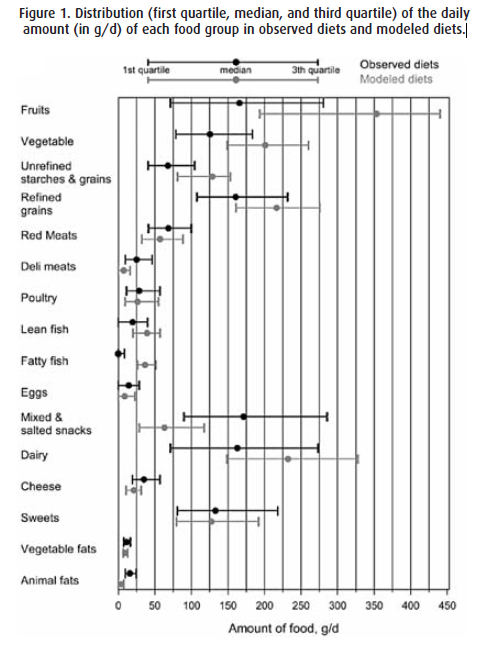Individual diet modeling translates nutrient recommendations into realistic and individual-specific food choices
Dietary guidelines called into question
Dietary guidelines have been developed to facilitate the attainment of nutrient recommendations at population level1-3, but they do not take into account food preferences and other individual specificities which may impair their effectiveness4. In addition, dietary guidelines almost ignore the complexity of the food supply. They do not provide recommendations for real foods, but refer to categories of foods, which are not well-defined and do not account for complex food products such as mixed dishes and snacks. The dietary choices needed to fulfill nutrientbased recommendations at the individual level deserve further exploration. Our objective was to specify the dietary changes needed to achieve a full set of nutrient-based recommendations for each individual in a French adult population, while accounting for individual food consumption patterns.
A new approach to identify nutritionally adequate food choices: individual diet modeling
Using the French dietary survey INCA1 “Enquête Individuelle et Nationale sur les Consommations Alimentaires” conducted in 19995, individual diet (ID) models were developed to design a nutritionally adequate diet for each of the 1,171 French adults. The dietary data were 7-d food records. Starting from each individual weekly food intake (observed diets), an isocaloric diet was modeled by linear programming6,7 to simultaneously meet the recommendations for 32 nutrients while deviating the least from the observed food intake. The WHO recommendations8 were used for total carbohydrates, free sugars and saturated fatty acids; the Nordic Nutrient Recommendations9 were used for the limit of sodium and the French recommendations10 were used as a target for all others nutrients (proteins, total fats, polyunsaturated, fibers, vitamins, minerals and cholesterol). To ensure the least deviation from the observed diets, ID models preferentially chose foods declared as consumed by each individual during the survey, i.e. repertoire-foods, and minimized the decrease in the quantity of those foods. When necessary, non-repertoirefoods were also introduced, preferentially selecting the most frequently consumed foods by the French population.
Many different ways to reach nutrient needs
A new individual diet meeting all the nutrient recommendations was obtained for each individual in the population. The isocaloric modeled diets invariably had a greater weight than their corresponding observed diets meaning that people have to consume diets of lower Energy density. The amount of foods selected in the modeled diets varied from individual to individual, and this variability followed that found in observed diets (Figure 1). This means that nutrient needs can be fulfilled in many different ways, depending on initial individual food patterns.
The priority dietary changes need to be focused on fruits, vegetables, nuts and fatty fish
Refined grains, unrefined starches, fresh dairy products (milk and yogurts), lean fish, and fatty fish were almost always increased to reach nutrient recommendations (Figure 1). In contrast, poultry, eggs, and vegetable fats were seldom modified by the optimization process. Decreases were observed for animal fats (from 15 to 5 g/d), mixed dishes (from 165 to 60 g/d), deli meats (from 25 to 8 g/d) while the amount of sweets decreased for 50% of individuals and increased for 50% of individuals. The highest increase in modeled diets compared with observed diets was observed for fruits (median from 170 to 350g/d) and for vegetables (median from 125 to 200g/d) (Figure 1).
Walnuts and fatty fish (mainly salmon) were the only foods which were systematically added when they were not present in the observed diets, and their median amounts in modeled diets were 15 and 37 g/d, respectively.

Conclusions
This new individual diet modeling approach offers the possibility of translating nutrient recommendations into realistic food choices for all individuals from a representative population. The results showed that nutrient needs can be fulfilled in many different ways, depending on initial individual food patterns. However, the priority dietary changes need to be focused on fruits, vegetables, nuts and fatty fish.
References
- Britten P et al. J Nutr Educ Behav. 2006;38: S78-S92.
- Vorster HH et al. Food Nutr Bull. 2007;28: S116-22.
- Joint WHO/FAO expert consultation (1998) Preparation and use of food-based dietary guidelines. In: Report of a joint expert consultation (WHO, ed. WHO tecnical report, Geneva.
- King JC. J Nutr. 2007;137: 480-3.
- Volatier JL. Enquête INCA (Individuelle et Nationale sur les Consommations Alimentaires).AFSSA, Agence Française de Sécurité Sanitaire des Aliments, Editor. Paris:Lavoisier;2000.
- Dantzig GB. The diet problem. Interfaces. 2002;20: 43-7.
- Smith VE. J Farm Econ. 1959;31: 272-83.
- Joint WHO/FAO expert consultation (2003) Diet, nutrition and the prevention of chronic diseases. In: WHO, Geneva. WHO technical report, Geneva.
- Nordic Council of Ministers. Nordic nutrition recommendations 2004. Integrating nutrition and physical activity. Copenhagen:Copenhagen: Nordic Council of Ministers, 2004;2004.
- Martin A. Apports nutritionnels conseillés pour la population française. Paris:Lavoisier;2001.
